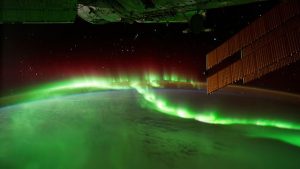Keep the Night On: Artificial Lighting on Our Coast
What is artificial lighting?
Artificial lighting refers to lights placed near the shoreline that alter where, when, how much, and what wavelengths of light are present. Commonly termed “light pollution,” this excess light comes from a variety of sources, including streetlights in residential or commercial areas, advertising lighting, architectural lighting, and vehicle lighting. These different forms of lighting differ in their timing and intensity, creating a patchwork of excess light reaching coastal habitats. In highly urbanized areas such as Southern California, the combination of multiple artificial light sources over a broad area can create a diffuse “sky glow” in addition to more direct impacts.

Image: The California coast lights up from space. Credit: Micheal Konig.
Why it’s a problem
Artificial light in marine and coastal areas can have a variety of negative impacts on habitats and species, including seabirds, migratory songbirds and tidepool animals. Birds can suffer from “light entrapment” and become unable to leave the illuminated area until they become exhausted or collide with a structure or window. Additionally, several species of small seabirds, including some threatened and endangered types of shearwaters and murrelets, feed at night in order to avoid predation. Artificial lighting can disrupt this strategy and increase their risk of capture and injury by predators.
Science also suggests that artificial lighting can impact our local intertidal environments. Illuminating otherwise dark shorelines allows visually-oriented tidepool and marine predators to better see their prey, increasing the susceptibility of prey species in these areas to predation. Artificial lighting also blurs the difference between day and night, disorienting organisms and causing novel overlaps between species that are generally active during different portions of the day.
Protecting Our MPAs
California’s statewide network of marine protected areas (MPAs), designated by the 1999 Marine Life Protection Act, is the largest in the country. Over a third of the MPAs statewide are located in Southern California. These special places balance conservation of coastal habitats and important species with opportunities for public access. Many of the MPAs in Southern California are open for a variety of recreational activities, from swimming and SCUBA diving to fishing. Ensuring these areas continue to both protect coastal ecosystems and provide recreational opportunities requires that special measures be taken to protect them.
Artificial lighting is a concern all along the coastline, but additional measures should be taken to reduce or eliminate artificial lighting near MPAs. Especially in Southern California, where many MPAs are adjacent to densely populated areas, local property owners should carefully consider the potential environmental impacts when deciding if, where, and how to install lighting near the shore. Due to the cumulative effects of light pollution, even a small amount of additional lighting can cause problems.
Reducing artificial lighting is one important way we can protect the species that call the shoreline home, and be good stewards of California’s majestic coastal environment.
How you can help
Interested in being a good neighbor to the many species that call Southern California beaches and tidepools home? If you own or manage property near the coast, there are steps you can take to protect California’s coastal environments from light pollution.
- Does your property have lighting that could impact marine life along the coast?
- Remember that many animal species can see in light levels much lower than those in which our vision functions. Light that is barely perceptible to the human eye may still be sufficient to impact coastal species.
- Even if your property isn’t immediately adjacent to the shoreline, you may still be contributing to “sky glow” and adding to the aggregate light pollution in urban areas.
- If yes, is the lighting necessary for public safety?
- No? Consider removing the lighting.
- Yes? Investigate alternative options. Flexible response lighting systems that are triggered by movement are a great option. Also consider lights that emit a narrow band of wavelengths, rather than broad spectrum “white lights.”
There is still much we don’t know about how light affects ecosystems along the Southern California coastline, but a precautionary approach to lighting minimizes the potential impacts.
Related Links:
-“Keep the Night On” informational two-pager
-Audubon’s “Lights Out” Program
-Light map of California-National Geographic: Light Pollution Taking a Toll on Wildlife, Eco-Groups Say
-International Dark Sky Association: Light Pollution Effects on Wildlife and Ecosystems
Related Scientific Literature:
Davies, T.W., Coleman, M., Griffith K.M., Jenkins S.R., 2015. Night-time lighting alters the composition of marine epifaunal communities. Biology Letters, 11(4),
Gaston, K.J., Visser, M.E., Holker, F. 2015. The biological impacts of artificial light at night: the research challenge. Philosophical Transactions of the Royal Society B, 370(1667),
Gehring, J., Kerlinger, P., Manville, A.M. 2009. Communication towers, lights, and birds: successful methods of reducing the frequency of avian collisions. Ecological Applications, 19(2): 505-514.
Marquenie, J., Donners, M., Poot, H., Steckel, W., de Wit, B. 2008. Adapting the spectral composition of artificial lighting to safeguard the environment.
Poot, H., Ens, B.J., de Vries, H, Donners, M.A., Wernand, M.R., Marquenie J.M. 2008. Green light for nocturnally migrating birds. Ecology and Society 13(2): 47.
Rodriguez, A. Rodrigeuz, B., Negro J.J. 2015. GPS tracking for mapping seabird mortality induced by light pollution. Scientific Reports, 5 10670, DOI: 10.1038/srep10670.
Weise, F.K., Montevecchi, W.A., Davoren, G.K., Huettmann, F., Diamond, A.W., Linke, J. 2001. Seabirds at risk around offshore oil platforms in the North-west Atlantic. Marine Pollution Bulletin, 42(12): 1285-1290.

